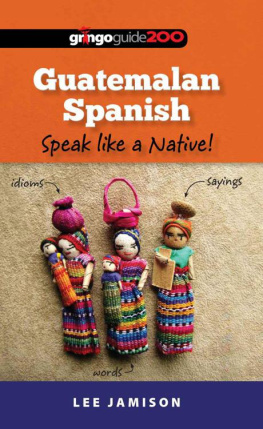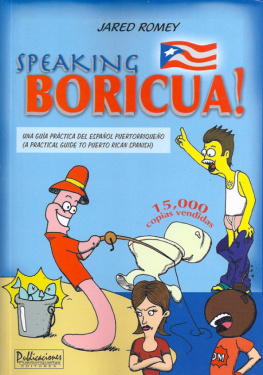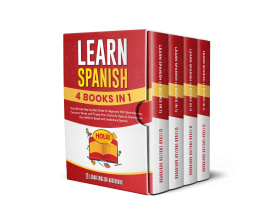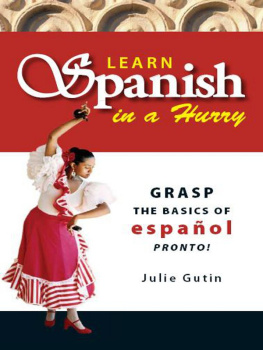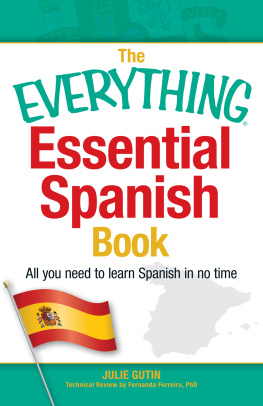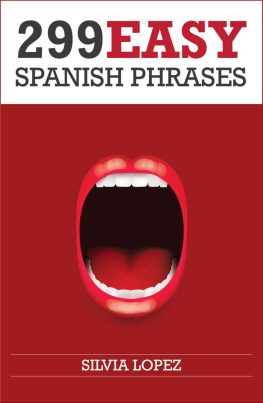
Guatemalan Spanish
Speak like a Native!
L E E J A M I S O N
Copyright 2013 Lee Jamison
All rights reserved.
Visit us at www.gringoguide200.com
First Printing: 2013. The editorial arrangement, analysis, and professional commentary are subject to this copyright notice. No portion of this book may be copied, retransmitted, reposted, duplicated, or otherwise used without the express written approval of the author, except by reviewers who may quote brief excerpts in connection with a review.
United States laws and regulations are public domain and not subject to copyright. Any unauthorized copying, reproduction, translation, or distribution of any part of this material without permission by the author is prohibited and against the law.
Disclaimer and Terms of Use: No information contained in this book should be considered as financial, tax, or legal advice. Your reliance upon information and content obtained by you at or through this publication is solely at your own risk. The author assumes no liability or responsibility for damage or injury to you, other persons, or property arising from any use of any product, information, idea, or instruction contained in the content or services provided to you through this book. Reliance upon information contained in this material is solely at the readers own risk.
Photo credits:
Cover: Guatemalan dolls, Lee Jamison; Burlap texture background, Hayati Kayhan - Fotolia.com; Arco de Santa Catalina, Antigua Guatemala, Oscar Espinosa - Fotolia.com; Lago Atitln, Guatemala, KM-Photography - Fotolia.com; Latin American fabrics, Ariane Citron - Fotolia.com; Mayan Tikal Ruins, Guatemala, hotshotsworldwide - Fotolia.com; Fillettes mayas, Ariane Citron - Fotolia.com; Section 1: dog on the phone, javier brosch - Fotolia.com; Section 2: Baby relaxing, yanlev - Fotolia.com; Section 3: Antigua, charles taylor - Fotolia.com; Section 4: Food for thought, Tijana - Fotolia.com; Section 5: anatomy, muscles, adimas - Fotolia.com; Section 6: Group of pets - Dog, cat, bird, reptile, rabbit, Eric Issele - Fotolia.com; Section 7: Smiley im Kaffee, Marco2811 - Fotolia.com; Section 8: candles, hitdelight - Fotolia.com; Section 9: masks, olly - Fotolia.com; Section 10: Gold egg, HP_Photo - Fotolia.com;
To my mother Janice,
for all your guidance in the early years.

Table of Contents
SECTION 1
SECTION 2
SECTION 3
SECTION 4
SECTION 5
SECTION 6
SECTION 7
SECTION 8
SECTION 9
SECTION 10

Introduction
AN international organization had recently merged personnel from several Latin American countries. A Mexican explained to a group of Guatemalans that there were still a lot of holes, or huecos, in the department. The listeners erupted in laughter. In their Spanish, huecos is slang for homosexuals.
In another conversation someone said that he had crashed his car, or coche. But again came giggles from the other end. In Guatemala, coches are pigs, not cars. Have you crashed yours lately?
All piggishness aside, in the global marketplace just knowing Spanish is not enough. Learning the country-specific peculiarities of the language is the only way to avoid potentially costly misunderstandings. The goal of the GringoGuide200 series of books is to help you to do just that. Imitating regional speech dignifies the locals. And even though to them you are the foreigner, some may well come to regard you as one of the family. Your efforts will definitely be rewardedmany times over!
Are you thinking of visiting Guatemala or are you living there now? Do you have family there or from there? Or are you just a language buff? Whatever the case, we urge you: Join the linguistic party! Instead of stubbornly clinging to phrasebook Spanish, have an open mind! Embrace those new but yet unfamiliar words and phrases! The more local words, phrases, and sayings you begin to use in your daily vocabulary, the more you will fit in.
One size does not fit all
The avalanche of books on Spanish has left us knee deep in a language that no one actually speaks. Real Hispanics dont read out of phrasebooks. To them they are as stale as week-old bread. Everyday speech is full of color that is country-specific. Consider:
The generic word for white is blanco. But when describing a light-skinned person, Mexicans will instinctively use the term gero. In El Salvador, Nicaragua and Honduras they say chele. In Panama its fulo, but as you will see in this volume, the residents of the Land of Eternal Spring will invariably speak of a .
Thats where the GringoGuide200 series comes in. In this volume, we dont teach you Spanish; we teach you to make your Spanish more Guatemalan , to speak like a native. How? We have made an effort to identify 200 words and phrases that are endemic to the country. We cannot dogmatically state that they are only used in Guatemala. Immigration agents dont detain words at the border, as if they had need of passports. Nevertheless, as a group they are like a fingerprint that unequivocally identifies the Spanish of any given country. For any Guatemalan who finds himself far from his native land, these words will be music to his hears.
Why 200?
One common saying is El que mucho abarca, poco aprieta. It literally means: He who tries to encompass a lot, squeezes a little. The idea is that we shouldnt spread ourselves too thin. We give you 200 words and phrases because we want to satisfy your thirstnot drown you! There is another consideration as well. My mother tongue is English and I have read many books on English words and sayings. And you know what? A large portion I have never heard in my lifetime! Never! Some Spanish language phrasebooks are just as all-inclusive. But how do you know if that phrase was known and used by 100 people or a 100,000? We s ave you the time by sorting that out for you. We hand you an eclectic selection to practice and perfect.
How to use this book
Guatemalan Spanish: Speak like a Native! is divided into ten sections. Check out the table of contents and jump to the one that most interests you. Others read just one entry a day and then try to practice that new word or phrase as soon as possible. That way you own it.
Only one or two terms appear on each page. This will help your focus. For many entries a literal meaning is provided. This often sounds unnatural in English, but can be an aid to memory. Where the headings In a nutshell appear, we help you understand the origin behind many of the popular sayings that make Guatemalan Spanish such a delight to listen to. Sometimes we throw in a tip or two as to when using that phrase would be appropriate. Just a few pronunciations are provided for words that may initially throw foreigners for a loop.
In the main text, Guatemalan words and phrases appear in bold type. Shortly thereafter the translation of the phrase will appear in italics . In many cases, sample sentences were ripped right from the headlines or newspaper articles that have appeared in the Guatemalan press. GringoGuide200 merely collects these quotes and they do not represent the opinion of the author. Since Spanish and English differ in punctuation styles, we here favor the English style even in Spanish quotes.
Lastly, feel free to use the terms listed here in everyday speech. Our selection is informal, but devoid of vulgarities.
Next page
